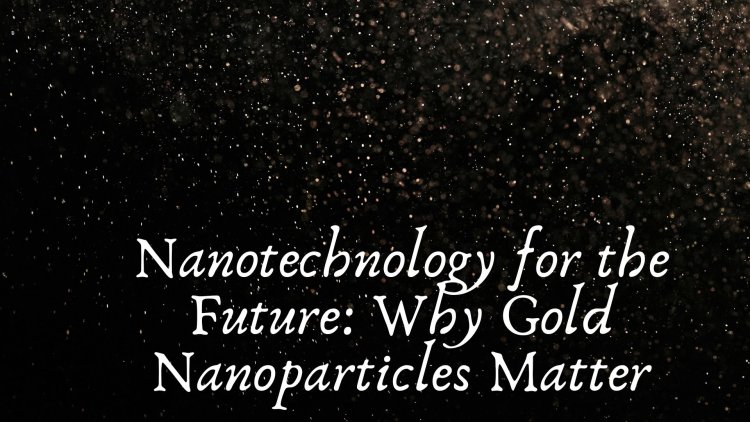Nanotechnology for the Future: Why Gold Nanoparticles Matter
Gold nanoparticles exemplify the transformative power of nanotechnology. Their applications in medicine, environment,
Share this Post to earn Money ( Upto ₹100 per 1000 Views )

Nanotechnology is at the forefront of scientific innovation, revolutionizing industries from healthcare to electronics. Among the myriad nanomaterials explored, gold nanoparticles (AuNPs) stand out for their unique properties and versatile applications. This article delves into why gold nanoparticles matter and how they are shaping the future.
What Are Gold Nanoparticles?
Gold nanoparticles are tiny gold particles with a size range between 1 and 100 nanometers. At this nanoscale, gold exhibits remarkable physical and chemical properties, distinct from its bulk counterpart. These include:
-
Surface Plasmon Resonance (SPR): Gold nanoparticles absorb and scatter light in unique ways, making them highly effective in optical and imaging applications.
-
Biocompatibility: AuNPs are non-toxic and compatible with biological systems, which is crucial for medical applications.
-
Chemical Stability: They resist oxidation and degradation, ensuring long-term functionality in various environments.
-
Surface Functionalization: The surface of gold nanoparticles can be easily modified with biomolecules, polymers, or other functional groups for specific applications.
Applications in Medicine
Targeted Drug Delivery
Gold nanoparticles serve as carriers for drugs, delivering therapeutic agents directly to diseased cells. By attaching ligands to their surfaces, AuNPs can target specific cell receptors, reducing side effects and increasing treatment efficacy.
Cancer Diagnostics and Therapy
The SPR property of gold nanoparticles enables them to enhance imaging techniques such as photoacoustic imaging and Raman spectroscopy, aiding in early cancer detection. In therapy, AuNPs are used in photothermal treatments, where they convert light into heat to destroy cancer cells selectively.
Biosensors
Gold nanoparticles enhance the sensitivity of biosensors used in detecting biomarkers for diseases. Their high surface area and conductivity improve the performance of diagnostic devices.
Vaccines
AuNPs are being explored as adjuvants to boost immune responses in vaccine formulations. Their ability to present antigens in a controlled manner can enhance vaccine efficacy.
Environmental and Energy Applications
Catalysis
Gold nanoparticles act as efficient catalysts in chemical reactions, including those for reducing pollutants and synthesizing fine chemicals. Their high surface area and reactivity make them ideal for green chemistry applications.
Water Purification
Functionalized gold nanoparticles are used in removing heavy metals and contaminants from water, offering a sustainable solution to water scarcity and pollution.
Energy Storage
In renewable energy, AuNPs enhance the efficiency of photovoltaic cells and play a role in developing next-generation batteries and fuel cells.
Advances in Electronics
Gold nanoparticles are integral to miniaturizing electronic components. Their excellent conductivity and ability to form stable connections are leveraged in:
-
Flexible Electronics: AuNPs are used in conductive inks for creating bendable circuits.
-
Sensors: They improve the sensitivity and response time of electronic sensors.
-
Memory Devices: AuNPs are explored for use in non-volatile memory applications, paving the way for faster and more reliable data storage solutions.
Challenges and Future Directions
While the potential of gold nanoparticles is immense, challenges remain:
-
Cost: Gold is an expensive material, and scaling up nanoparticle production cost-effectively is a hurdle.
-
Toxicity Concerns: Although biocompatible, the long-term effects of AuNPs in biological systems need thorough investigation.
-
Regulatory Hurdles: Establishing standardized protocols for their use in medicine and industry is crucial.
Research is ongoing to address these challenges. Advances in synthesis methods, such as green chemistry approaches, aim to reduce costs and environmental impact. Collaborative efforts between academia, industry, and regulatory bodies are streamlining the development and commercialization of AuNP-based technologies.
Conclusion
Gold nanoparticles exemplify the transformative power of nanotechnology. Their applications in medicine, environment, and electronics underscore their significance in addressing global challenges and driving innovation. As research progresses, gold nanoparticles are poised to become a cornerstone of technological advancement, heralding a future where the small truly is mighty.

 Online Services
Online Services 













